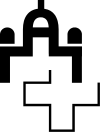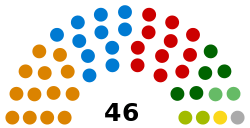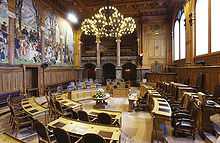Council of States (Switzerland)
| Council of States German: Ständerat French: Conseil des Etats Italian: Consiglio degli Stati Romansh: Cussegl dals Stadis | |
|---|---|
 | |
| Type | |
| Type | |
| Leadership | |
First Vice President | |
Second Vice President | |
| Structure | |
| Seats | 46 |
 | |
Political groups |
Government parties (41) |
| Elections | |
Last election | 23 October 2011 |
| Meeting place | |
 | |
| Federal Palace of Switzerland, Bern | |
| Website | |
| http://www.parliament.ch/ | |
.svg.png) |
| This article is part of a series on the politics and government of Switzerland |
|
Federal Assembly
|
|
Administrative divisions
|
|
Politics portal |
The Council of States (German: Ständerat, French: Conseil des Etats, Italian: Consiglio degli Stati, Romansh: Cussegl dals Stadis) is the smaller chamber of the Federal Assembly of Switzerland, and is considered the Assembly's upper house. There are 46 Councillors.
Twenty of the country's cantons are represented by two Councillors each. Six cantons, traditionally called "half cantons", are represented by one Councillor each for historical reasons. These are Obwalden, Nidwalden, Basel-Stadt, Basel-Landschaft, Appenzell Ausserrhoden and Appenzell Innerrhoden.
The Councillors serve for four years, and are not bound in their vote to instructions from the Cantonal authorities. Under the Swiss Federal Constitution, the mode of election is left to the cantons, the proviso being that it must be a democratic method. However, all cantons now provide for the councillors to be chosen by popular election. In all cantons except for Zug and Appenzell Innerrhoden, the Councillors are elected concurrently with the members of the National Council. In the canton of Appenzell Innerrhoden the representatives are elected by the physically convened popular assembly (Landsgemeinde). With the exception of the Canton of Jura, where a proportional representation election system is used, the representatives are elected by majority vote.
As of 2008, there are 10 women in the Council of States, representing 22% of its membership.
Working languages
In debates, German (High German) and French are used. Italian and Romansh are not used in debates. Debates are not interpreted, which means all representatives must understand German and French.
List of members
- List of members of the Swiss Council of States (2007-2011)
- List of members of the Swiss Council of States (2003-2007)
- List of Presidents of the Swiss Council of States
Seats by party
| Parties | Ideology | 2007 | Seats | ± | |
|---|---|---|---|---|---|
| Christian Democratic People's Party (CVP/PDC) | Christian democracy | 15 | 13 | -2 | |
| FDP.The Liberals (FDP/PRD) | Classical liberalism | 12 | 11 | -1 | |
| Social Democratic Party (SPS/PSS) | Social democracy | 9 | 11 | +2 | |
| Swiss People's Party (SVP/UDC) | National conservatism | 7 | 5 | -2 | |
| Green Party (GPS/PES) | Green politics | 2 | 2 | ±0 | |
| Green Liberal Party (GLP/VL) | Green liberalism | 1 | 2 | +1 | |
| Conservative Democratic Party (BDP/PBD) | Conservatism / Economic liberalism | 0 | 1 | +1 | |
| Independent | Independent | 0 | 1 | +1 | |
| Total | 46 | 46 | |||
| Source: http://www.politik-stat.ch/srw2011CH_de.html | |||||
2007 election
| Parties | Ideology | 2003 | Seats | ± | |
|---|---|---|---|---|---|
| Christian Democratic People's Party (CVP/PDC) | Christian democracy | 15 | 15 | ±0 | |
| Free Democratic Party (FDP/PRD) | Classical liberalism | 14 | 12 | –2 | |
| Social Democratic Party (SPS/PSS) | Social democracy | 9 | 9 | ±0 | |
| Swiss People's Party (SVP/UDC) | National conservatism | 8 | 7 | –1 | |
| Green Party (GPS/PES) | Green politics | 0 | 2 | +2 | |
| Green Liberal Party (GLP/VL) | Green liberalism | 0 | 1 | +1 | |
| Total | 46 | 46 | |||
| Source: http://www.politik-stat.ch/srw2007CH_de.html | |||||
Population per seat
The Council of States represents the federal nature of Switzerland: seats are distributed by state (canton), not by population. Consequently, the number of people represented by a single seat in the Council of State varies by a factor of 40, from 15,000 for Appenzell Innerrhoden to 600,000 for Zurich.
| Abbr | Canton | Seats | Population ¹ | per seat | ² |
|---|---|---|---|---|---|
| ZH | Zurich | 2 | 1,228,600 | 614,300 | 1.0 |
| BE | Bern | 2 | 947,100 | 473,550 | 1.3 |
| VD | Vaud | 2 | 626,200 | 313,100 | 2.0 |
| AG | Aargau | 2 | 550,900 | 275,450 | 2.2 |
| BL | Basel-Landschaft | 1 | 261,400 | 261,400 | 2.4 |
| SG | St. Gallen | 2 | 452,600 | 226,300 | 2.7 |
| GE | Geneva | 2 | 414,300 | 207,150 | 3.0 |
| BS | Basel-Stadt | 1 | 186,700 | 186,700 | 3.3 |
| LU | Lucerne | 2 | 350,600 | 175,300 | 3.5 |
| TI | Ticino | 2 | 311,900 | 155,950 | 3.9 |
| VS | Valais | 2 | 278,200 | 139,100 | 4.4 |
| SO | Solothurn | 2 | 245,500 | 122,750 | 5.0 |
| FR | Fribourg | 2 | 239,100 | 119,550 | 5.1 |
| TG | Thurgau | 2 | 228,200 | 114,100 | 5.4 |
| GR | Graubünden | 2 | 185,700 | 92,850 | 6.6 |
| NE | Neuchâtel | 2 | 166,500 | 83,250 | 7.4 |
| SZ | Schwyz | 2 | 131,400 | 65,700 | 9.4 |
| AR | Appenzell Ausserrhoden | 1 | 53,200 | 53,200 | 11.5 |
| ZG | Zug | 2 | 100,900 | 50,450 | 12.2 |
| NW | Nidwalden | 1 | 38,600 | 38,600 | 15.9 |
| SH | Schaffhausen | 2 | 73,400 | 36,700 | 16.7 |
| JU | Jura | 2 | 69,100 | 34,550 | 17.8 |
| OW | Obwalden | 1 | 32,700 | 32,700 | 18.8 |
| GL | Glarus | 2 | 38,300 | 19,150 | 32.1 |
| UR | Uri | 2 | 35,000 | 17,500 | 35.1 |
| AI | Appenzell Innerrhoden | 1 | 15,000 | 15,000 | 41.0 |
| Overall | 46 | 7,261,200 | 157,852 | 3.9 | |
Notes: ¹ Population data from Cantons of Switzerland (2001). ² Relative representation compared to Zürich.
Notes and references
External links
| Wikimedia Commons has media related to Federal Palace of Switzerland. |
| ||||||||||||||||||||||